Floodwater Development and Disaster Mitigation: Coastal Reservoirs
VerifiedAdded on 2021/06/17
|25
|6578
|20
Report
AI Summary
This report delves into the concept of coastal reservoirs as a crucial element in floodwater management and disaster mitigation. It begins by addressing the increasing demand for water in coastal zones and the resulting scarcity, emphasizing the need for sustainable resource management. The report explores the advantages of coastal reservoirs over inland dams, such as reduced risk factors and minimal displacement of communities. It investigates various strategies for floodwater management, including the assessment of geographical information systems (GIS) tools to resolve engineering challenges. The research poses questions about the examples, construction strategies, mitigating factors, and engineering bases for coastal reservoirs. The literature review examines the existing studies and articles concerning floodwater disaster mitigation and coastal reservoirs for floodwater development. The concept of coastal reservoirs for floodwater development is discussed, highlighting water accessibility and sustainable practices to manage floodwater through the development of coastal reservoirs. The report also touches upon the comparison of water quality from different sources and their implications on the coastal reservoirs. The report concludes by emphasizing the importance of coastal reservoirs in harvesting excess water, modifying flood effects, and reducing the adverse impact on individuals and communities. The study incorporates structural and nonstructural policies to manage flood risks and offers a comprehensive overview of the design and construction of coastal reservoirs to ensure sustainable flood management.
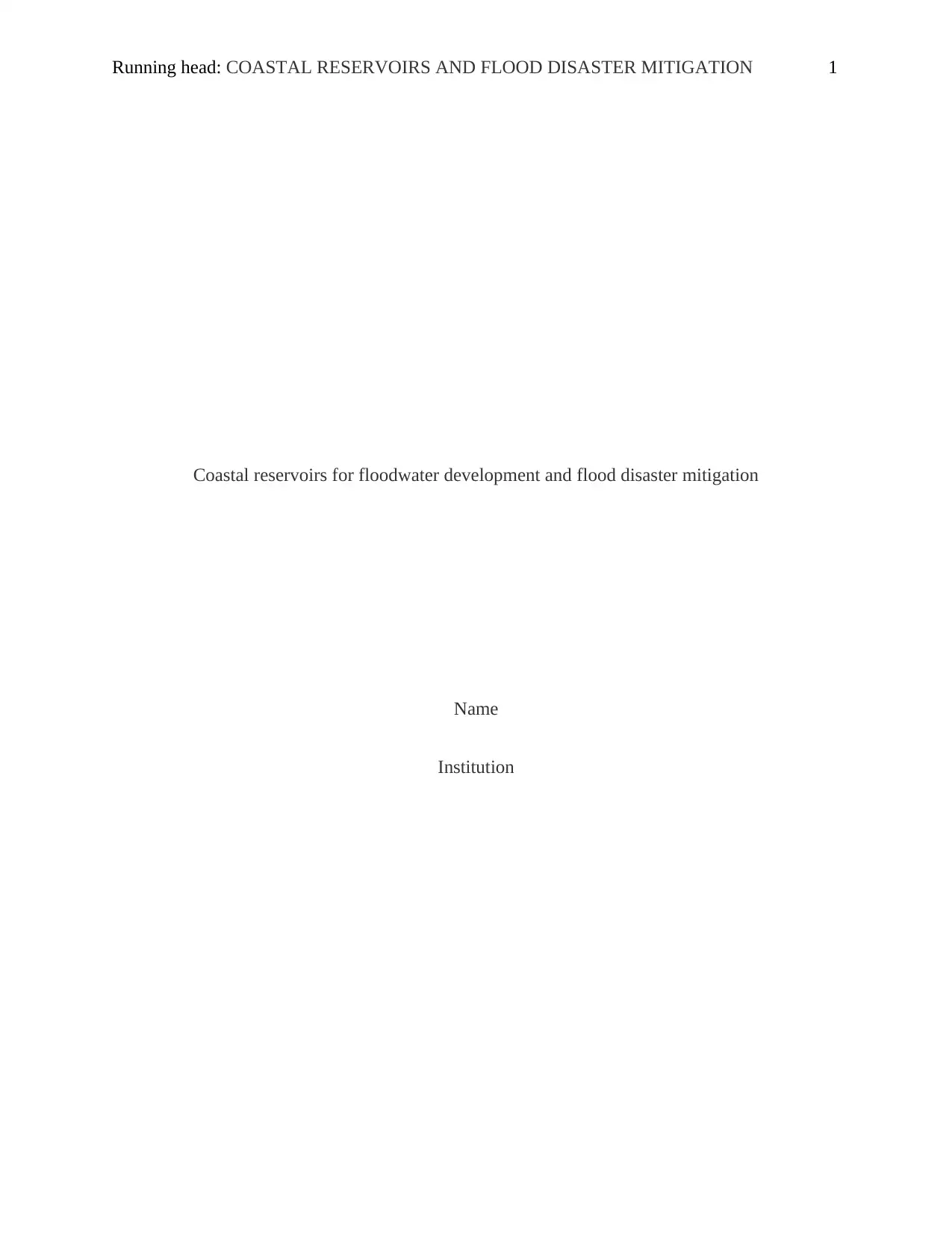
Running head: COASTAL RESERVOIRS AND FLOOD DISASTER MITIGATION 1
Coastal reservoirs for floodwater development and flood disaster mitigation
Name
Institution
Coastal reservoirs for floodwater development and flood disaster mitigation
Name
Institution
Paraphrase This Document
Need a fresh take? Get an instant paraphrase of this document with our AI Paraphraser
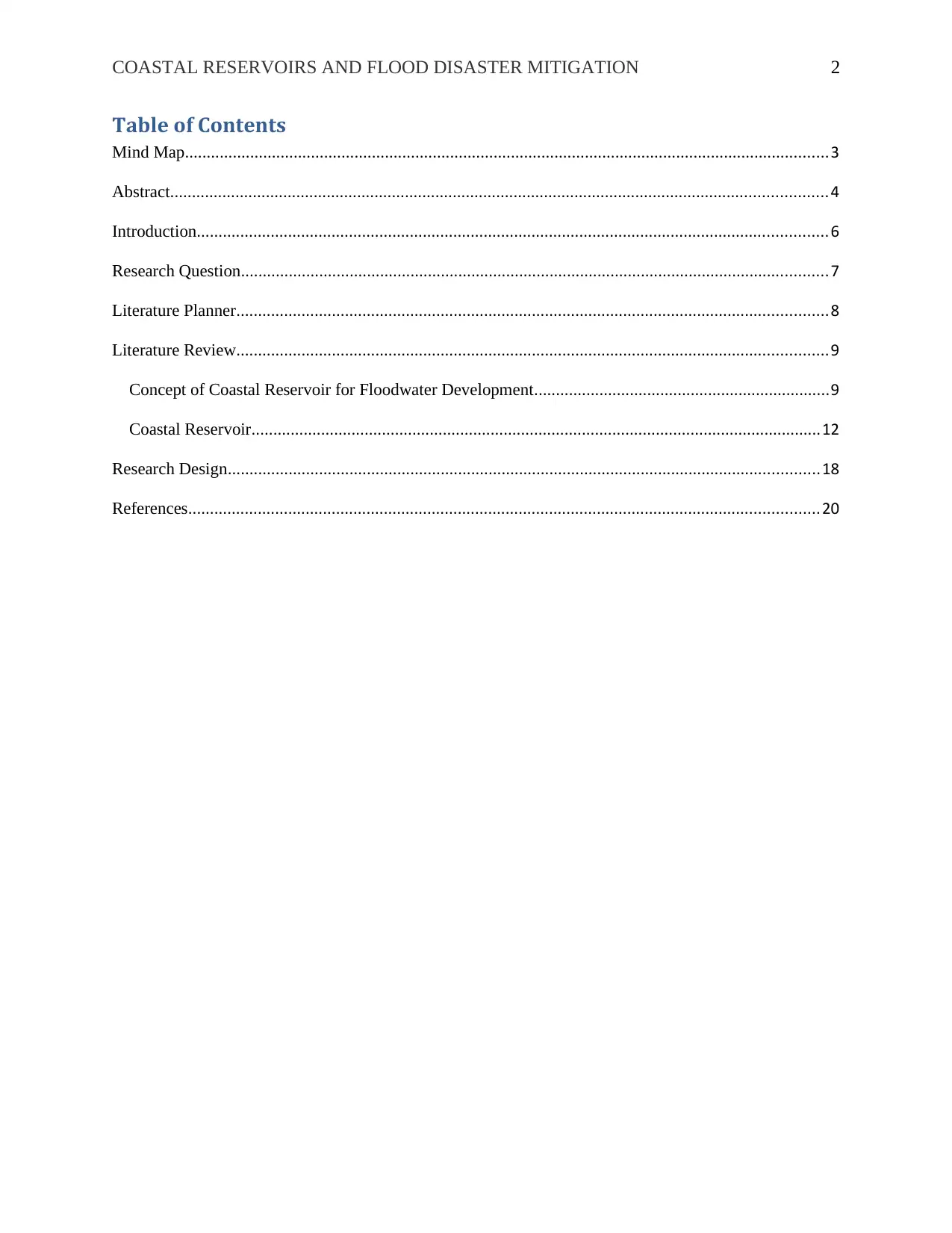
COASTAL RESERVOIRS AND FLOOD DISASTER MITIGATION 2
Table of Contents
Mind Map....................................................................................................................................................3
Abstract.......................................................................................................................................................4
Introduction.................................................................................................................................................6
Research Question.......................................................................................................................................7
Literature Planner........................................................................................................................................8
Literature Review........................................................................................................................................9
Concept of Coastal Reservoir for Floodwater Development....................................................................9
Coastal Reservoir...................................................................................................................................12
Research Design........................................................................................................................................18
References.................................................................................................................................................20
Table of Contents
Mind Map....................................................................................................................................................3
Abstract.......................................................................................................................................................4
Introduction.................................................................................................................................................6
Research Question.......................................................................................................................................7
Literature Planner........................................................................................................................................8
Literature Review........................................................................................................................................9
Concept of Coastal Reservoir for Floodwater Development....................................................................9
Coastal Reservoir...................................................................................................................................12
Research Design........................................................................................................................................18
References.................................................................................................................................................20
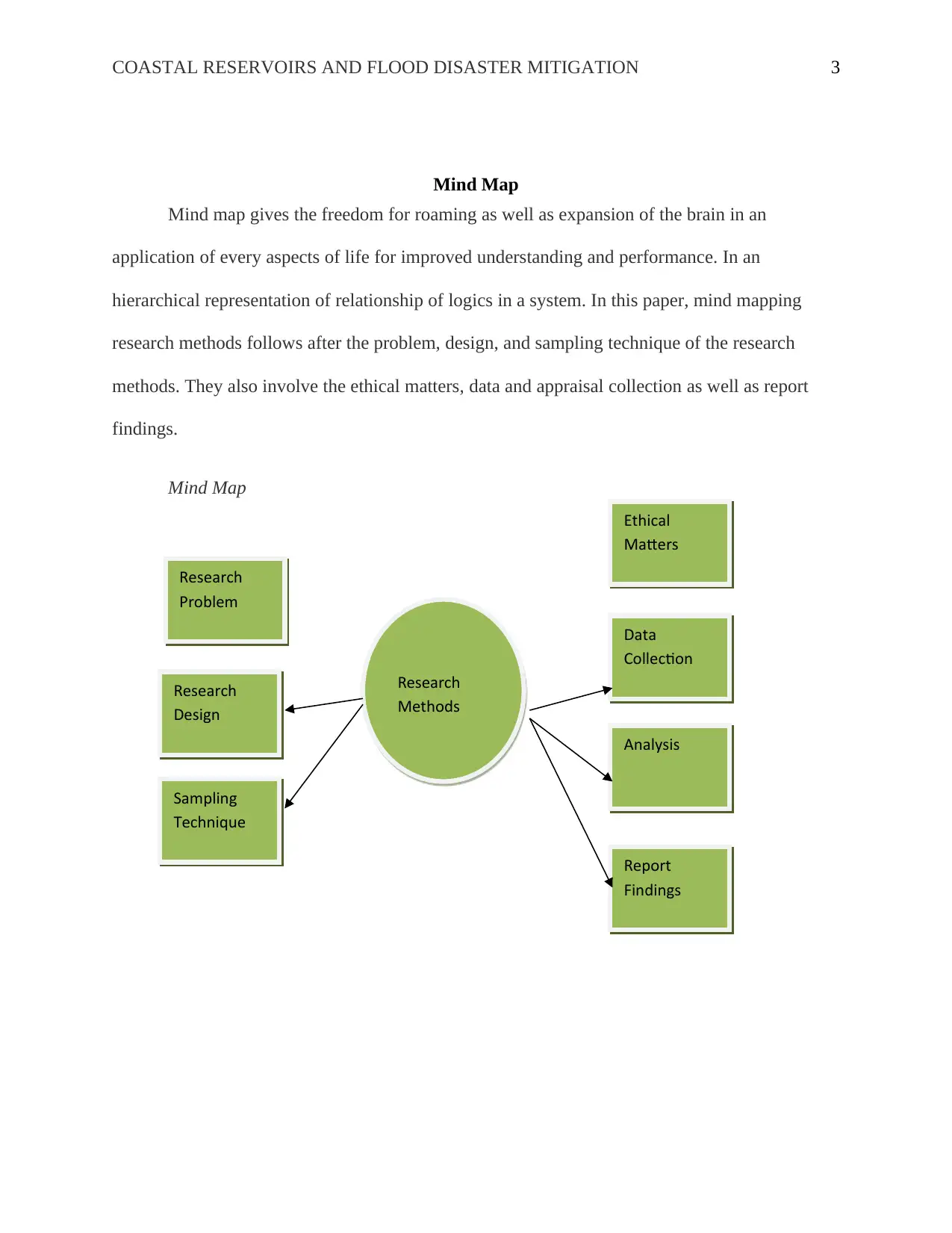
COASTAL RESERVOIRS AND FLOOD DISASTER MITIGATION 3
Mind Map
Mind map gives the freedom for roaming as well as expansion of the brain in an
application of every aspects of life for improved understanding and performance. In an
hierarchical representation of relationship of logics in a system. In this paper, mind mapping
research methods follows after the problem, design, and sampling technique of the research
methods. They also involve the ethical matters, data and appraisal collection as well as report
findings.
Mind Map
Research
Problem
Research
Design
Sampling
Technique
Data
Collection
Analysis
Report
Findings
Research
Methods
Ethical
Matters
Mind Map
Mind map gives the freedom for roaming as well as expansion of the brain in an
application of every aspects of life for improved understanding and performance. In an
hierarchical representation of relationship of logics in a system. In this paper, mind mapping
research methods follows after the problem, design, and sampling technique of the research
methods. They also involve the ethical matters, data and appraisal collection as well as report
findings.
Mind Map
Research
Problem
Research
Design
Sampling
Technique
Data
Collection
Analysis
Report
Findings
Research
Methods
Ethical
Matters
⊘ This is a preview!⊘
Do you want full access?
Subscribe today to unlock all pages.

Trusted by 1+ million students worldwide
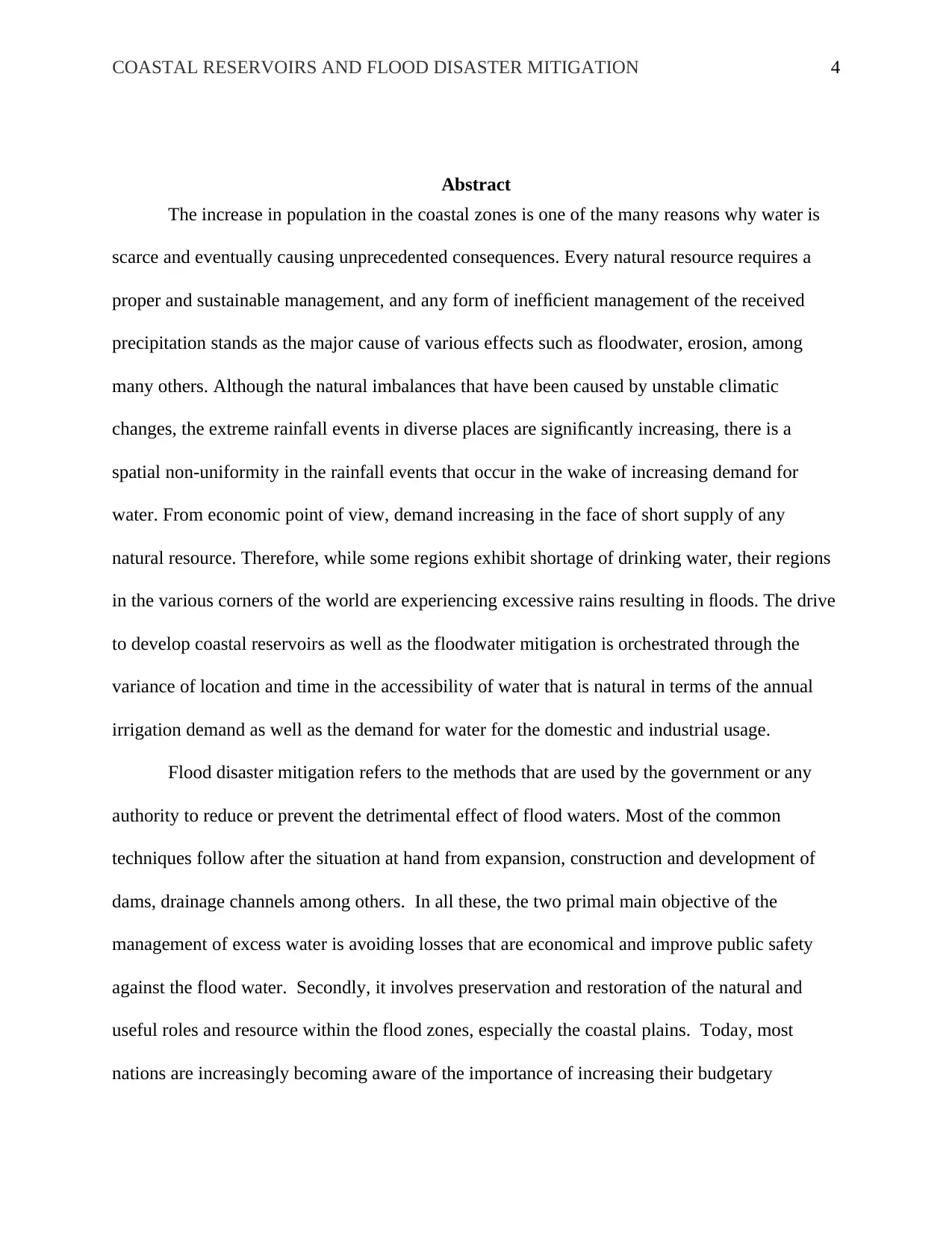
COASTAL RESERVOIRS AND FLOOD DISASTER MITIGATION 4
Abstract
The increase in population in the coastal zones is one of the many reasons why water is
scarce and eventually causing unprecedented consequences. Every natural resource requires a
proper and sustainable management, and any form of inefficient management of the received
precipitation stands as the major cause of various effects such as floodwater, erosion, among
many others. Although the natural imbalances that have been caused by unstable climatic
changes, the extreme rainfall events in diverse places are significantly increasing, there is a
spatial non-uniformity in the rainfall events that occur in the wake of increasing demand for
water. From economic point of view, demand increasing in the face of short supply of any
natural resource. Therefore, while some regions exhibit shortage of drinking water, their regions
in the various corners of the world are experiencing excessive rains resulting in floods. The drive
to develop coastal reservoirs as well as the floodwater mitigation is orchestrated through the
variance of location and time in the accessibility of water that is natural in terms of the annual
irrigation demand as well as the demand for water for the domestic and industrial usage.
Flood disaster mitigation refers to the methods that are used by the government or any
authority to reduce or prevent the detrimental effect of flood waters. Most of the common
techniques follow after the situation at hand from expansion, construction and development of
dams, drainage channels among others. In all these, the two primal main objective of the
management of excess water is avoiding losses that are economical and improve public safety
against the flood water. Secondly, it involves preservation and restoration of the natural and
useful roles and resource within the flood zones, especially the coastal plains. Today, most
nations are increasingly becoming aware of the importance of increasing their budgetary
Abstract
The increase in population in the coastal zones is one of the many reasons why water is
scarce and eventually causing unprecedented consequences. Every natural resource requires a
proper and sustainable management, and any form of inefficient management of the received
precipitation stands as the major cause of various effects such as floodwater, erosion, among
many others. Although the natural imbalances that have been caused by unstable climatic
changes, the extreme rainfall events in diverse places are significantly increasing, there is a
spatial non-uniformity in the rainfall events that occur in the wake of increasing demand for
water. From economic point of view, demand increasing in the face of short supply of any
natural resource. Therefore, while some regions exhibit shortage of drinking water, their regions
in the various corners of the world are experiencing excessive rains resulting in floods. The drive
to develop coastal reservoirs as well as the floodwater mitigation is orchestrated through the
variance of location and time in the accessibility of water that is natural in terms of the annual
irrigation demand as well as the demand for water for the domestic and industrial usage.
Flood disaster mitigation refers to the methods that are used by the government or any
authority to reduce or prevent the detrimental effect of flood waters. Most of the common
techniques follow after the situation at hand from expansion, construction and development of
dams, drainage channels among others. In all these, the two primal main objective of the
management of excess water is avoiding losses that are economical and improve public safety
against the flood water. Secondly, it involves preservation and restoration of the natural and
useful roles and resource within the flood zones, especially the coastal plains. Today, most
nations are increasingly becoming aware of the importance of increasing their budgetary
Paraphrase This Document
Need a fresh take? Get an instant paraphrase of this document with our AI Paraphraser
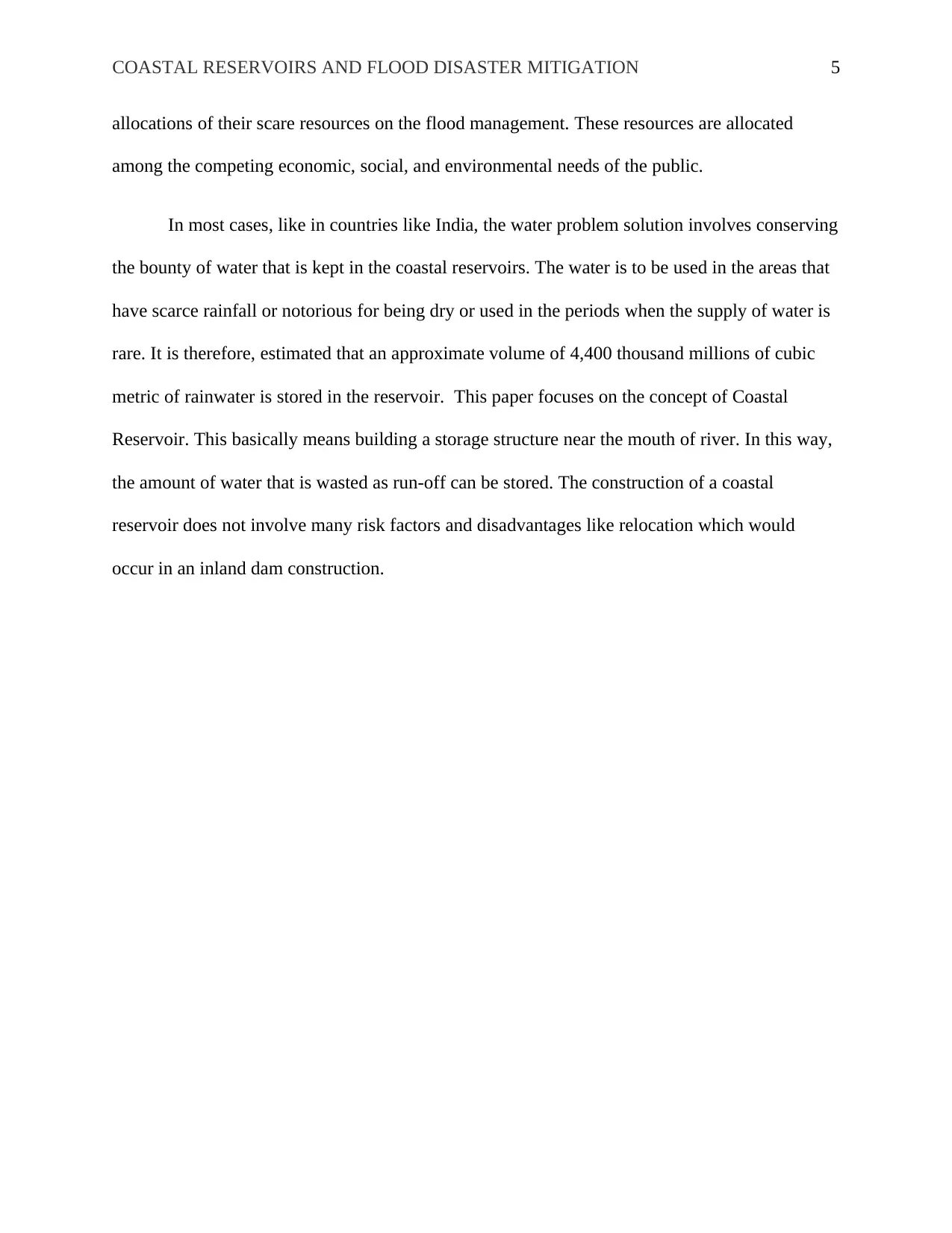
COASTAL RESERVOIRS AND FLOOD DISASTER MITIGATION 5
allocations of their scare resources on the flood management. These resources are allocated
among the competing economic, social, and environmental needs of the public.
In most cases, like in countries like India, the water problem solution involves conserving
the bounty of water that is kept in the coastal reservoirs. The water is to be used in the areas that
have scarce rainfall or notorious for being dry or used in the periods when the supply of water is
rare. It is therefore, estimated that an approximate volume of 4,400 thousand millions of cubic
metric of rainwater is stored in the reservoir. This paper focuses on the concept of Coastal
Reservoir. This basically means building a storage structure near the mouth of river. In this way,
the amount of water that is wasted as run-off can be stored. The construction of a coastal
reservoir does not involve many risk factors and disadvantages like relocation which would
occur in an inland dam construction.
allocations of their scare resources on the flood management. These resources are allocated
among the competing economic, social, and environmental needs of the public.
In most cases, like in countries like India, the water problem solution involves conserving
the bounty of water that is kept in the coastal reservoirs. The water is to be used in the areas that
have scarce rainfall or notorious for being dry or used in the periods when the supply of water is
rare. It is therefore, estimated that an approximate volume of 4,400 thousand millions of cubic
metric of rainwater is stored in the reservoir. This paper focuses on the concept of Coastal
Reservoir. This basically means building a storage structure near the mouth of river. In this way,
the amount of water that is wasted as run-off can be stored. The construction of a coastal
reservoir does not involve many risk factors and disadvantages like relocation which would
occur in an inland dam construction.
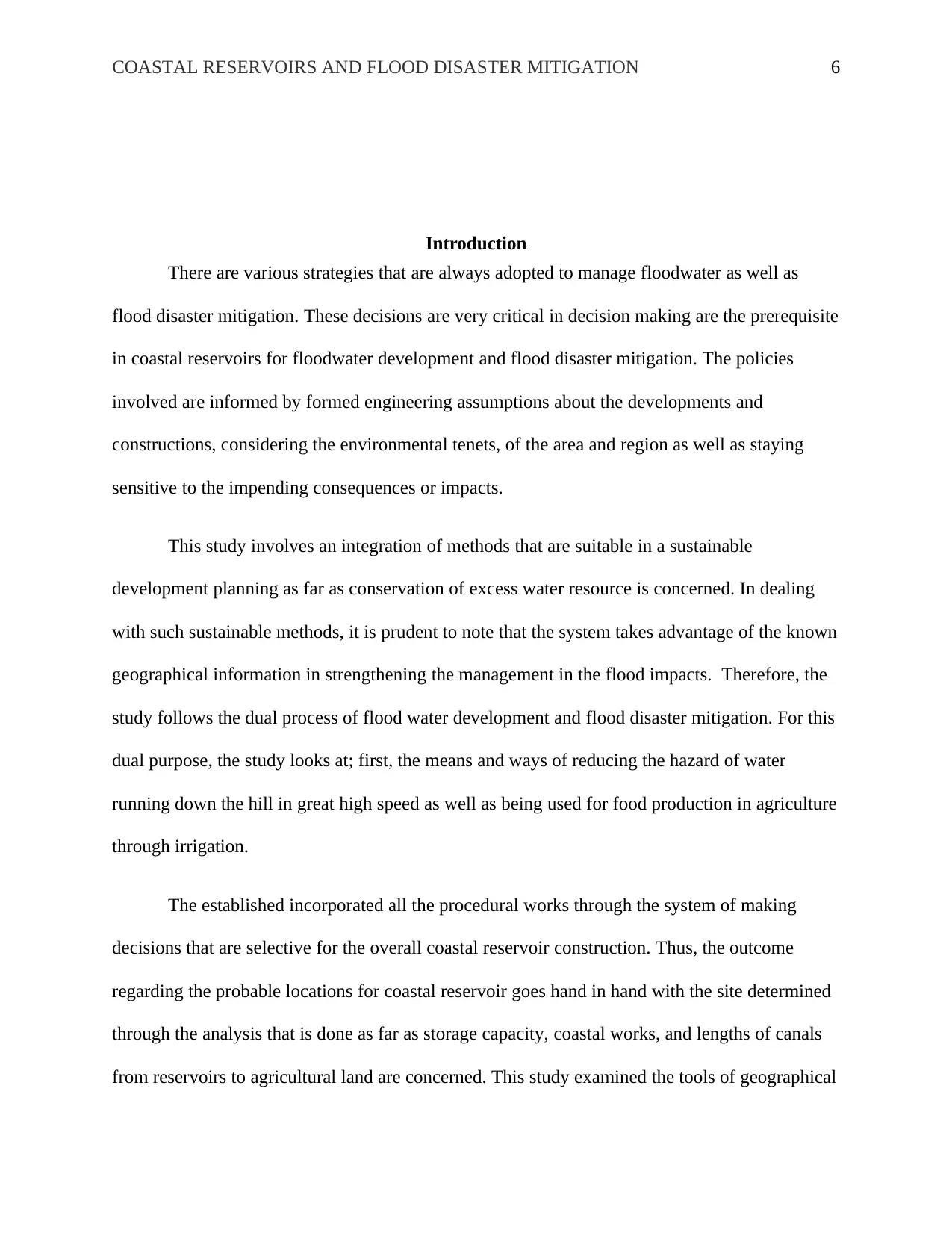
COASTAL RESERVOIRS AND FLOOD DISASTER MITIGATION 6
Introduction
There are various strategies that are always adopted to manage floodwater as well as
flood disaster mitigation. These decisions are very critical in decision making are the prerequisite
in coastal reservoirs for floodwater development and flood disaster mitigation. The policies
involved are informed by formed engineering assumptions about the developments and
constructions, considering the environmental tenets, of the area and region as well as staying
sensitive to the impending consequences or impacts.
This study involves an integration of methods that are suitable in a sustainable
development planning as far as conservation of excess water resource is concerned. In dealing
with such sustainable methods, it is prudent to note that the system takes advantage of the known
geographical information in strengthening the management in the flood impacts. Therefore, the
study follows the dual process of flood water development and flood disaster mitigation. For this
dual purpose, the study looks at; first, the means and ways of reducing the hazard of water
running down the hill in great high speed as well as being used for food production in agriculture
through irrigation.
The established incorporated all the procedural works through the system of making
decisions that are selective for the overall coastal reservoir construction. Thus, the outcome
regarding the probable locations for coastal reservoir goes hand in hand with the site determined
through the analysis that is done as far as storage capacity, coastal works, and lengths of canals
from reservoirs to agricultural land are concerned. This study examined the tools of geographical
Introduction
There are various strategies that are always adopted to manage floodwater as well as
flood disaster mitigation. These decisions are very critical in decision making are the prerequisite
in coastal reservoirs for floodwater development and flood disaster mitigation. The policies
involved are informed by formed engineering assumptions about the developments and
constructions, considering the environmental tenets, of the area and region as well as staying
sensitive to the impending consequences or impacts.
This study involves an integration of methods that are suitable in a sustainable
development planning as far as conservation of excess water resource is concerned. In dealing
with such sustainable methods, it is prudent to note that the system takes advantage of the known
geographical information in strengthening the management in the flood impacts. Therefore, the
study follows the dual process of flood water development and flood disaster mitigation. For this
dual purpose, the study looks at; first, the means and ways of reducing the hazard of water
running down the hill in great high speed as well as being used for food production in agriculture
through irrigation.
The established incorporated all the procedural works through the system of making
decisions that are selective for the overall coastal reservoir construction. Thus, the outcome
regarding the probable locations for coastal reservoir goes hand in hand with the site determined
through the analysis that is done as far as storage capacity, coastal works, and lengths of canals
from reservoirs to agricultural land are concerned. This study examined the tools of geographical
⊘ This is a preview!⊘
Do you want full access?
Subscribe today to unlock all pages.

Trusted by 1+ million students worldwide
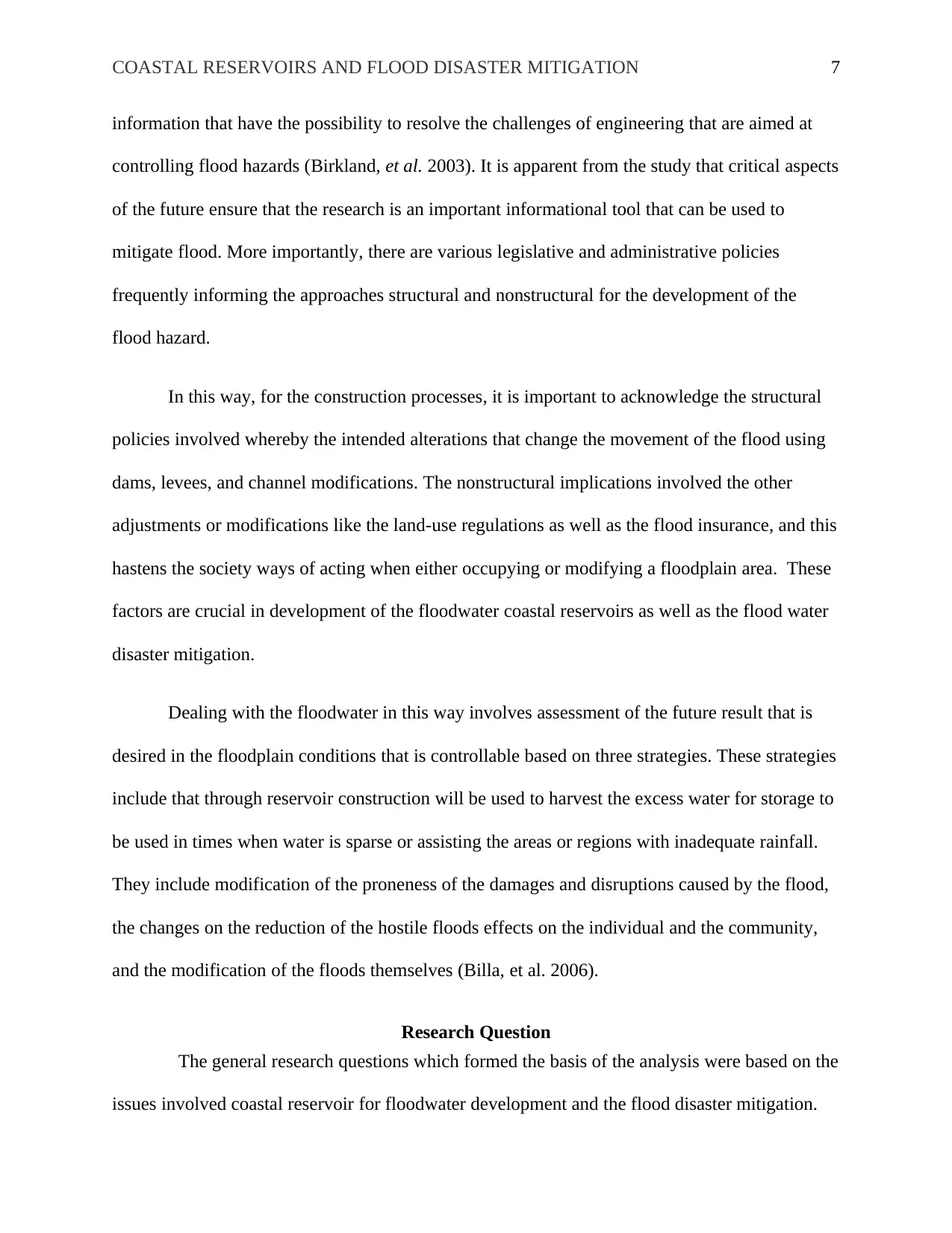
COASTAL RESERVOIRS AND FLOOD DISASTER MITIGATION 7
information that have the possibility to resolve the challenges of engineering that are aimed at
controlling flood hazards (Birkland, et al. 2003). It is apparent from the study that critical aspects
of the future ensure that the research is an important informational tool that can be used to
mitigate flood. More importantly, there are various legislative and administrative policies
frequently informing the approaches structural and nonstructural for the development of the
flood hazard.
In this way, for the construction processes, it is important to acknowledge the structural
policies involved whereby the intended alterations that change the movement of the flood using
dams, levees, and channel modifications. The nonstructural implications involved the other
adjustments or modifications like the land-use regulations as well as the flood insurance, and this
hastens the society ways of acting when either occupying or modifying a floodplain area. These
factors are crucial in development of the floodwater coastal reservoirs as well as the flood water
disaster mitigation.
Dealing with the floodwater in this way involves assessment of the future result that is
desired in the floodplain conditions that is controllable based on three strategies. These strategies
include that through reservoir construction will be used to harvest the excess water for storage to
be used in times when water is sparse or assisting the areas or regions with inadequate rainfall.
They include modification of the proneness of the damages and disruptions caused by the flood,
the changes on the reduction of the hostile floods effects on the individual and the community,
and the modification of the floods themselves (Billa, et al. 2006).
Research Question
The general research questions which formed the basis of the analysis were based on the
issues involved coastal reservoir for floodwater development and the flood disaster mitigation.
information that have the possibility to resolve the challenges of engineering that are aimed at
controlling flood hazards (Birkland, et al. 2003). It is apparent from the study that critical aspects
of the future ensure that the research is an important informational tool that can be used to
mitigate flood. More importantly, there are various legislative and administrative policies
frequently informing the approaches structural and nonstructural for the development of the
flood hazard.
In this way, for the construction processes, it is important to acknowledge the structural
policies involved whereby the intended alterations that change the movement of the flood using
dams, levees, and channel modifications. The nonstructural implications involved the other
adjustments or modifications like the land-use regulations as well as the flood insurance, and this
hastens the society ways of acting when either occupying or modifying a floodplain area. These
factors are crucial in development of the floodwater coastal reservoirs as well as the flood water
disaster mitigation.
Dealing with the floodwater in this way involves assessment of the future result that is
desired in the floodplain conditions that is controllable based on three strategies. These strategies
include that through reservoir construction will be used to harvest the excess water for storage to
be used in times when water is sparse or assisting the areas or regions with inadequate rainfall.
They include modification of the proneness of the damages and disruptions caused by the flood,
the changes on the reduction of the hostile floods effects on the individual and the community,
and the modification of the floods themselves (Billa, et al. 2006).
Research Question
The general research questions which formed the basis of the analysis were based on the
issues involved coastal reservoir for floodwater development and the flood disaster mitigation.
Paraphrase This Document
Need a fresh take? Get an instant paraphrase of this document with our AI Paraphraser
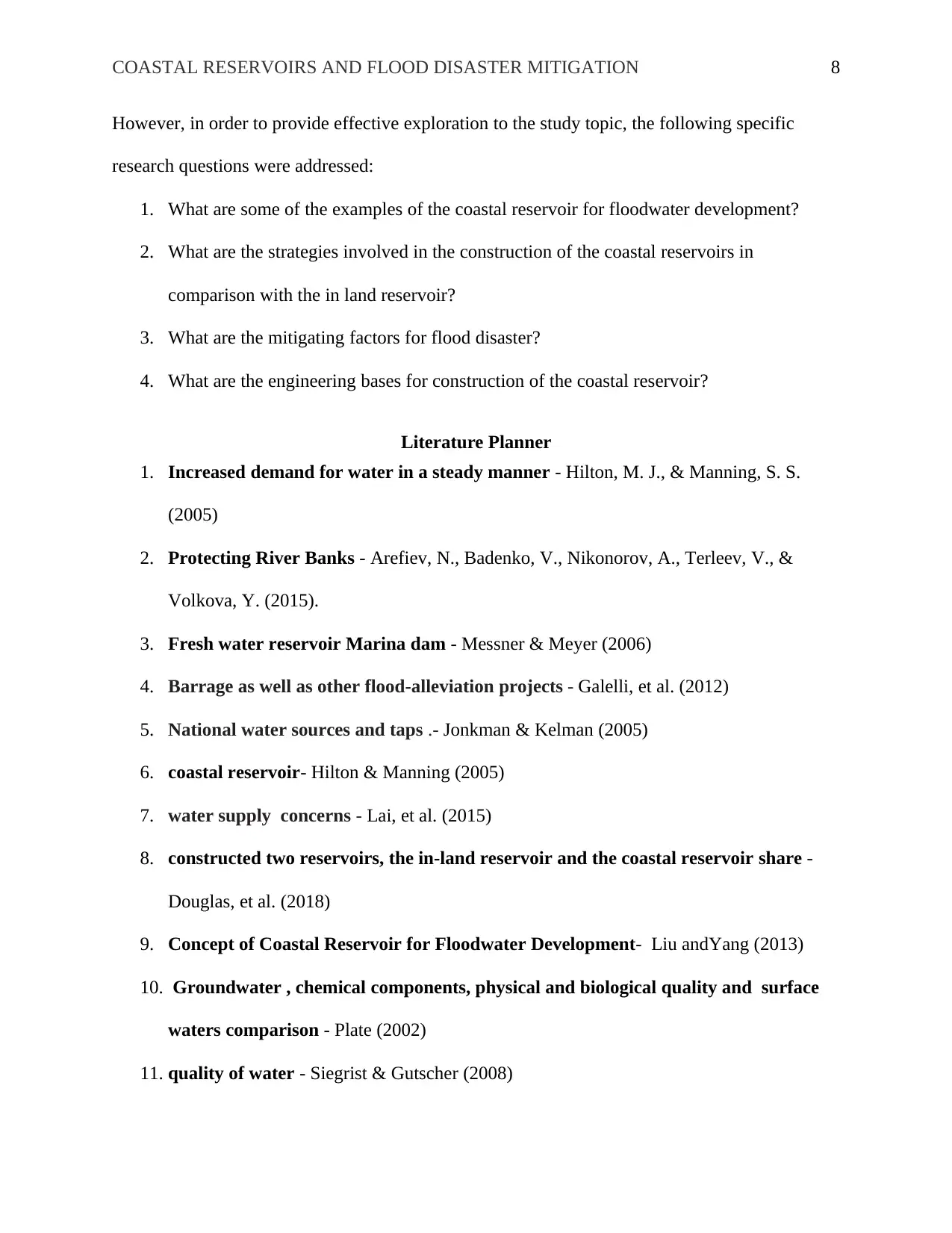
COASTAL RESERVOIRS AND FLOOD DISASTER MITIGATION 8
However, in order to provide effective exploration to the study topic, the following specific
research questions were addressed:
1. What are some of the examples of the coastal reservoir for floodwater development?
2. What are the strategies involved in the construction of the coastal reservoirs in
comparison with the in land reservoir?
3. What are the mitigating factors for flood disaster?
4. What are the engineering bases for construction of the coastal reservoir?
Literature Planner
1. Increased demand for water in a steady manner - Hilton, M. J., & Manning, S. S.
(2005)
2. Protecting River Banks - Arefiev, N., Badenko, V., Nikonorov, A., Terleev, V., &
Volkova, Y. (2015).
3. Fresh water reservoir Marina dam - Messner & Meyer (2006)
4. Barrage as well as other flood-alleviation projects - Galelli, et al. (2012)
5. National water sources and taps .- Jonkman & Kelman (2005)
6. coastal reservoir- Hilton & Manning (2005)
7. water supply concerns - Lai, et al. (2015)
8. constructed two reservoirs, the in-land reservoir and the coastal reservoir share -
Douglas, et al. (2018)
9. Concept of Coastal Reservoir for Floodwater Development- Liu andYang (2013)
10. Groundwater , chemical components, physical and biological quality and surface
waters comparison - Plate (2002)
11. quality of water - Siegrist & Gutscher (2008)
However, in order to provide effective exploration to the study topic, the following specific
research questions were addressed:
1. What are some of the examples of the coastal reservoir for floodwater development?
2. What are the strategies involved in the construction of the coastal reservoirs in
comparison with the in land reservoir?
3. What are the mitigating factors for flood disaster?
4. What are the engineering bases for construction of the coastal reservoir?
Literature Planner
1. Increased demand for water in a steady manner - Hilton, M. J., & Manning, S. S.
(2005)
2. Protecting River Banks - Arefiev, N., Badenko, V., Nikonorov, A., Terleev, V., &
Volkova, Y. (2015).
3. Fresh water reservoir Marina dam - Messner & Meyer (2006)
4. Barrage as well as other flood-alleviation projects - Galelli, et al. (2012)
5. National water sources and taps .- Jonkman & Kelman (2005)
6. coastal reservoir- Hilton & Manning (2005)
7. water supply concerns - Lai, et al. (2015)
8. constructed two reservoirs, the in-land reservoir and the coastal reservoir share -
Douglas, et al. (2018)
9. Concept of Coastal Reservoir for Floodwater Development- Liu andYang (2013)
10. Groundwater , chemical components, physical and biological quality and surface
waters comparison - Plate (2002)
11. quality of water - Siegrist & Gutscher (2008)
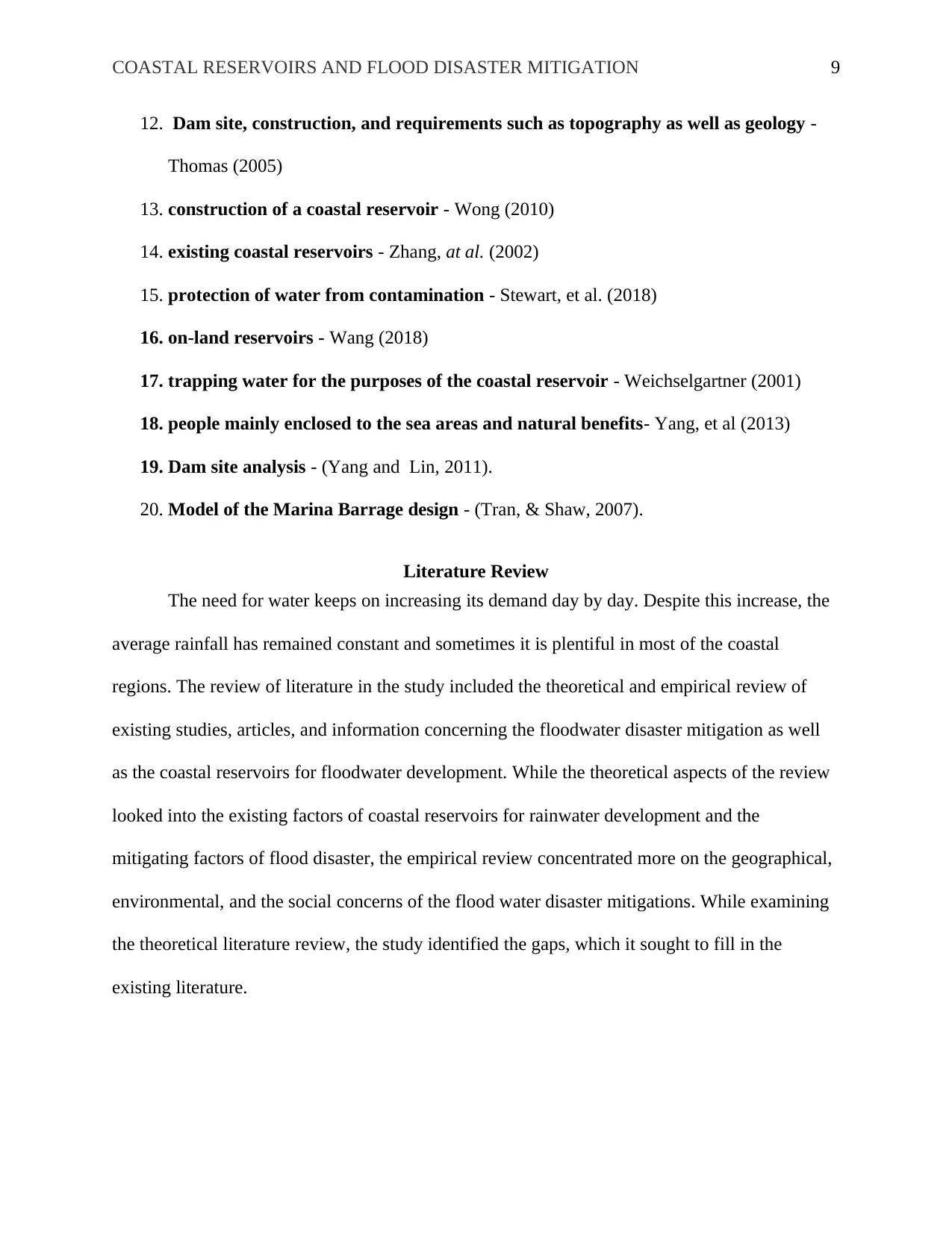
COASTAL RESERVOIRS AND FLOOD DISASTER MITIGATION 9
12. Dam site, construction, and requirements such as topography as well as geology -
Thomas (2005)
13. construction of a coastal reservoir - Wong (2010)
14. existing coastal reservoirs - Zhang, at al. (2002)
15. protection of water from contamination - Stewart, et al. (2018)
16. on-land reservoirs - Wang (2018)
17. trapping water for the purposes of the coastal reservoir - Weichselgartner (2001)
18. people mainly enclosed to the sea areas and natural benefits- Yang, et al (2013)
19. Dam site analysis - (Yang and Lin, 2011).
20. Model of the Marina Barrage design - (Tran, & Shaw, 2007).
Literature Review
The need for water keeps on increasing its demand day by day. Despite this increase, the
average rainfall has remained constant and sometimes it is plentiful in most of the coastal
regions. The review of literature in the study included the theoretical and empirical review of
existing studies, articles, and information concerning the floodwater disaster mitigation as well
as the coastal reservoirs for floodwater development. While the theoretical aspects of the review
looked into the existing factors of coastal reservoirs for rainwater development and the
mitigating factors of flood disaster, the empirical review concentrated more on the geographical,
environmental, and the social concerns of the flood water disaster mitigations. While examining
the theoretical literature review, the study identified the gaps, which it sought to fill in the
existing literature.
12. Dam site, construction, and requirements such as topography as well as geology -
Thomas (2005)
13. construction of a coastal reservoir - Wong (2010)
14. existing coastal reservoirs - Zhang, at al. (2002)
15. protection of water from contamination - Stewart, et al. (2018)
16. on-land reservoirs - Wang (2018)
17. trapping water for the purposes of the coastal reservoir - Weichselgartner (2001)
18. people mainly enclosed to the sea areas and natural benefits- Yang, et al (2013)
19. Dam site analysis - (Yang and Lin, 2011).
20. Model of the Marina Barrage design - (Tran, & Shaw, 2007).
Literature Review
The need for water keeps on increasing its demand day by day. Despite this increase, the
average rainfall has remained constant and sometimes it is plentiful in most of the coastal
regions. The review of literature in the study included the theoretical and empirical review of
existing studies, articles, and information concerning the floodwater disaster mitigation as well
as the coastal reservoirs for floodwater development. While the theoretical aspects of the review
looked into the existing factors of coastal reservoirs for rainwater development and the
mitigating factors of flood disaster, the empirical review concentrated more on the geographical,
environmental, and the social concerns of the flood water disaster mitigations. While examining
the theoretical literature review, the study identified the gaps, which it sought to fill in the
existing literature.
⊘ This is a preview!⊘
Do you want full access?
Subscribe today to unlock all pages.

Trusted by 1+ million students worldwide
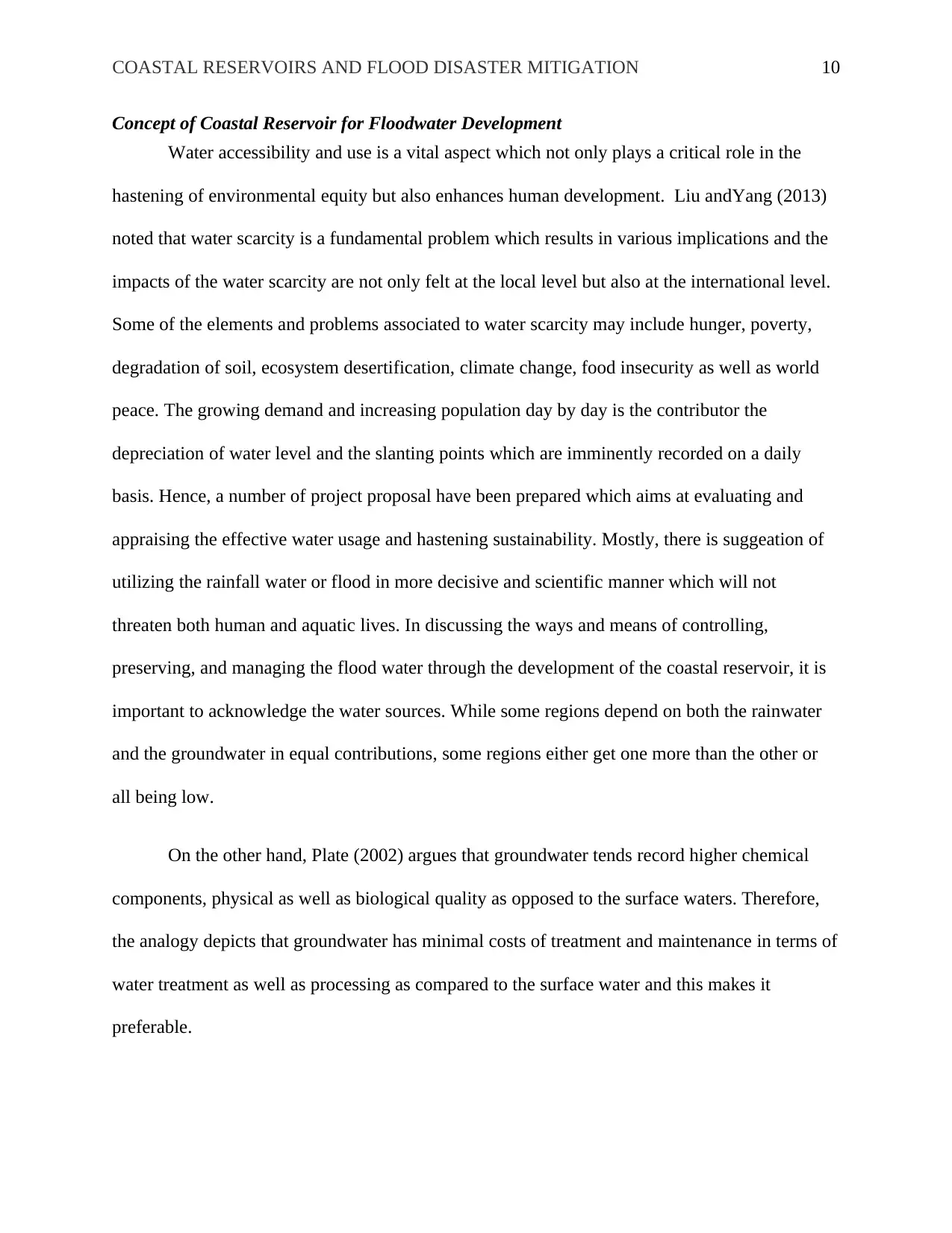
COASTAL RESERVOIRS AND FLOOD DISASTER MITIGATION 10
Concept of Coastal Reservoir for Floodwater Development
Water accessibility and use is a vital aspect which not only plays a critical role in the
hastening of environmental equity but also enhances human development. Liu andYang (2013)
noted that water scarcity is a fundamental problem which results in various implications and the
impacts of the water scarcity are not only felt at the local level but also at the international level.
Some of the elements and problems associated to water scarcity may include hunger, poverty,
degradation of soil, ecosystem desertification, climate change, food insecurity as well as world
peace. The growing demand and increasing population day by day is the contributor the
depreciation of water level and the slanting points which are imminently recorded on a daily
basis. Hence, a number of project proposal have been prepared which aims at evaluating and
appraising the effective water usage and hastening sustainability. Mostly, there is suggeation of
utilizing the rainfall water or flood in more decisive and scientific manner which will not
threaten both human and aquatic lives. In discussing the ways and means of controlling,
preserving, and managing the flood water through the development of the coastal reservoir, it is
important to acknowledge the water sources. While some regions depend on both the rainwater
and the groundwater in equal contributions, some regions either get one more than the other or
all being low.
On the other hand, Plate (2002) argues that groundwater tends record higher chemical
components, physical as well as biological quality as opposed to the surface waters. Therefore,
the analogy depicts that groundwater has minimal costs of treatment and maintenance in terms of
water treatment as well as processing as compared to the surface water and this makes it
preferable.
Concept of Coastal Reservoir for Floodwater Development
Water accessibility and use is a vital aspect which not only plays a critical role in the
hastening of environmental equity but also enhances human development. Liu andYang (2013)
noted that water scarcity is a fundamental problem which results in various implications and the
impacts of the water scarcity are not only felt at the local level but also at the international level.
Some of the elements and problems associated to water scarcity may include hunger, poverty,
degradation of soil, ecosystem desertification, climate change, food insecurity as well as world
peace. The growing demand and increasing population day by day is the contributor the
depreciation of water level and the slanting points which are imminently recorded on a daily
basis. Hence, a number of project proposal have been prepared which aims at evaluating and
appraising the effective water usage and hastening sustainability. Mostly, there is suggeation of
utilizing the rainfall water or flood in more decisive and scientific manner which will not
threaten both human and aquatic lives. In discussing the ways and means of controlling,
preserving, and managing the flood water through the development of the coastal reservoir, it is
important to acknowledge the water sources. While some regions depend on both the rainwater
and the groundwater in equal contributions, some regions either get one more than the other or
all being low.
On the other hand, Plate (2002) argues that groundwater tends record higher chemical
components, physical as well as biological quality as opposed to the surface waters. Therefore,
the analogy depicts that groundwater has minimal costs of treatment and maintenance in terms of
water treatment as well as processing as compared to the surface water and this makes it
preferable.
Paraphrase This Document
Need a fresh take? Get an instant paraphrase of this document with our AI Paraphraser
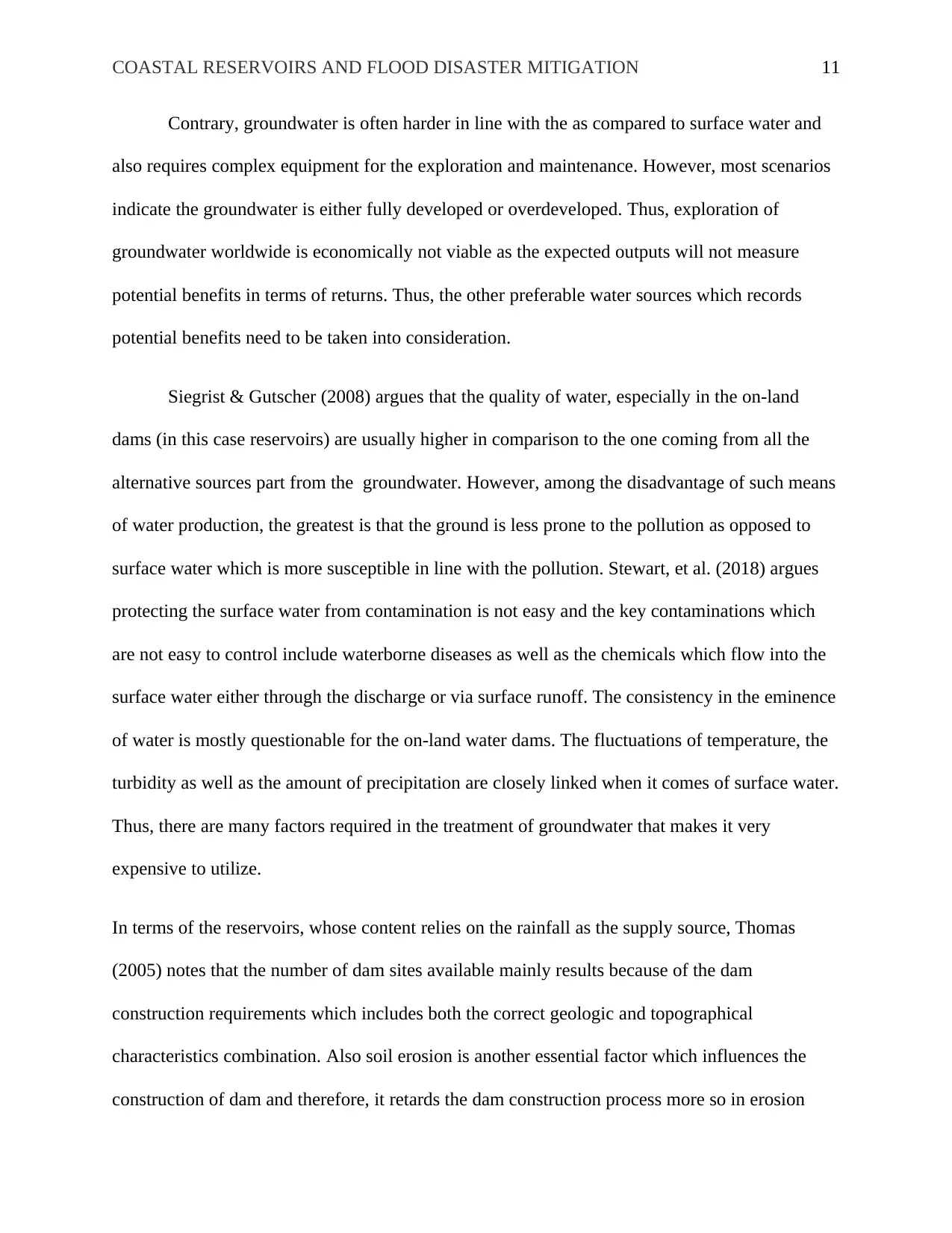
COASTAL RESERVOIRS AND FLOOD DISASTER MITIGATION 11
Contrary, groundwater is often harder in line with the as compared to surface water and
also requires complex equipment for the exploration and maintenance. However, most scenarios
indicate the groundwater is either fully developed or overdeveloped. Thus, exploration of
groundwater worldwide is economically not viable as the expected outputs will not measure
potential benefits in terms of returns. Thus, the other preferable water sources which records
potential benefits need to be taken into consideration.
Siegrist & Gutscher (2008) argues that the quality of water, especially in the on-land
dams (in this case reservoirs) are usually higher in comparison to the one coming from all the
alternative sources part from the groundwater. However, among the disadvantage of such means
of water production, the greatest is that the ground is less prone to the pollution as opposed to
surface water which is more susceptible in line with the pollution. Stewart, et al. (2018) argues
protecting the surface water from contamination is not easy and the key contaminations which
are not easy to control include waterborne diseases as well as the chemicals which flow into the
surface water either through the discharge or via surface runoff. The consistency in the eminence
of water is mostly questionable for the on-land water dams. The fluctuations of temperature, the
turbidity as well as the amount of precipitation are closely linked when it comes of surface water.
Thus, there are many factors required in the treatment of groundwater that makes it very
expensive to utilize.
In terms of the reservoirs, whose content relies on the rainfall as the supply source, Thomas
(2005) notes that the number of dam sites available mainly results because of the dam
construction requirements which includes both the correct geologic and topographical
characteristics combination. Also soil erosion is another essential factor which influences the
construction of dam and therefore, it retards the dam construction process more so in erosion
Contrary, groundwater is often harder in line with the as compared to surface water and
also requires complex equipment for the exploration and maintenance. However, most scenarios
indicate the groundwater is either fully developed or overdeveloped. Thus, exploration of
groundwater worldwide is economically not viable as the expected outputs will not measure
potential benefits in terms of returns. Thus, the other preferable water sources which records
potential benefits need to be taken into consideration.
Siegrist & Gutscher (2008) argues that the quality of water, especially in the on-land
dams (in this case reservoirs) are usually higher in comparison to the one coming from all the
alternative sources part from the groundwater. However, among the disadvantage of such means
of water production, the greatest is that the ground is less prone to the pollution as opposed to
surface water which is more susceptible in line with the pollution. Stewart, et al. (2018) argues
protecting the surface water from contamination is not easy and the key contaminations which
are not easy to control include waterborne diseases as well as the chemicals which flow into the
surface water either through the discharge or via surface runoff. The consistency in the eminence
of water is mostly questionable for the on-land water dams. The fluctuations of temperature, the
turbidity as well as the amount of precipitation are closely linked when it comes of surface water.
Thus, there are many factors required in the treatment of groundwater that makes it very
expensive to utilize.
In terms of the reservoirs, whose content relies on the rainfall as the supply source, Thomas
(2005) notes that the number of dam sites available mainly results because of the dam
construction requirements which includes both the correct geologic and topographical
characteristics combination. Also soil erosion is another essential factor which influences the
construction of dam and therefore, it retards the dam construction process more so in erosion
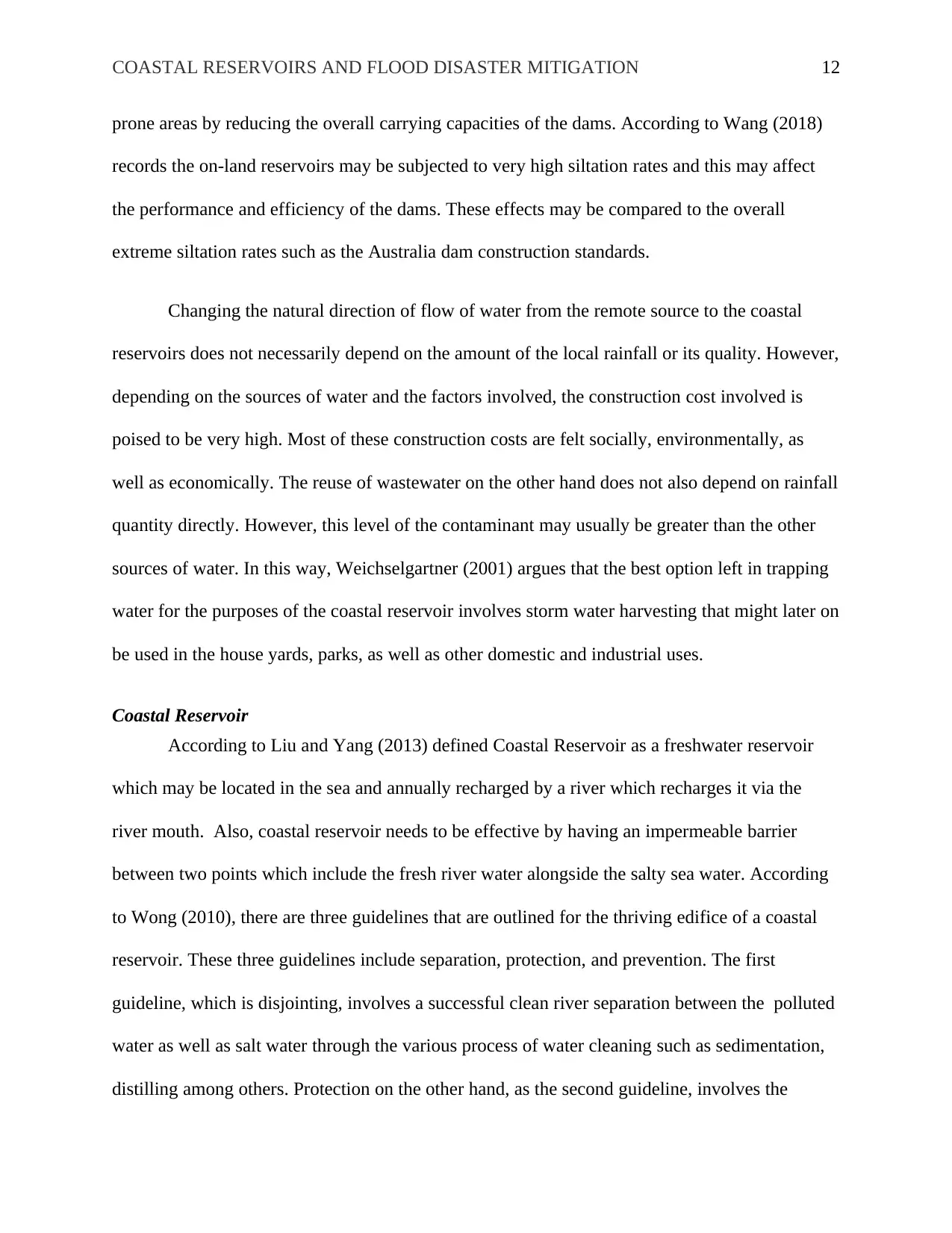
COASTAL RESERVOIRS AND FLOOD DISASTER MITIGATION 12
prone areas by reducing the overall carrying capacities of the dams. According to Wang (2018)
records the on-land reservoirs may be subjected to very high siltation rates and this may affect
the performance and efficiency of the dams. These effects may be compared to the overall
extreme siltation rates such as the Australia dam construction standards.
Changing the natural direction of flow of water from the remote source to the coastal
reservoirs does not necessarily depend on the amount of the local rainfall or its quality. However,
depending on the sources of water and the factors involved, the construction cost involved is
poised to be very high. Most of these construction costs are felt socially, environmentally, as
well as economically. The reuse of wastewater on the other hand does not also depend on rainfall
quantity directly. However, this level of the contaminant may usually be greater than the other
sources of water. In this way, Weichselgartner (2001) argues that the best option left in trapping
water for the purposes of the coastal reservoir involves storm water harvesting that might later on
be used in the house yards, parks, as well as other domestic and industrial uses.
Coastal Reservoir
According to Liu and Yang (2013) defined Coastal Reservoir as a freshwater reservoir
which may be located in the sea and annually recharged by a river which recharges it via the
river mouth. Also, coastal reservoir needs to be effective by having an impermeable barrier
between two points which include the fresh river water alongside the salty sea water. According
to Wong (2010), there are three guidelines that are outlined for the thriving edifice of a coastal
reservoir. These three guidelines include separation, protection, and prevention. The first
guideline, which is disjointing, involves a successful clean river separation between the polluted
water as well as salt water through the various process of water cleaning such as sedimentation,
distilling among others. Protection on the other hand, as the second guideline, involves the
prone areas by reducing the overall carrying capacities of the dams. According to Wang (2018)
records the on-land reservoirs may be subjected to very high siltation rates and this may affect
the performance and efficiency of the dams. These effects may be compared to the overall
extreme siltation rates such as the Australia dam construction standards.
Changing the natural direction of flow of water from the remote source to the coastal
reservoirs does not necessarily depend on the amount of the local rainfall or its quality. However,
depending on the sources of water and the factors involved, the construction cost involved is
poised to be very high. Most of these construction costs are felt socially, environmentally, as
well as economically. The reuse of wastewater on the other hand does not also depend on rainfall
quantity directly. However, this level of the contaminant may usually be greater than the other
sources of water. In this way, Weichselgartner (2001) argues that the best option left in trapping
water for the purposes of the coastal reservoir involves storm water harvesting that might later on
be used in the house yards, parks, as well as other domestic and industrial uses.
Coastal Reservoir
According to Liu and Yang (2013) defined Coastal Reservoir as a freshwater reservoir
which may be located in the sea and annually recharged by a river which recharges it via the
river mouth. Also, coastal reservoir needs to be effective by having an impermeable barrier
between two points which include the fresh river water alongside the salty sea water. According
to Wong (2010), there are three guidelines that are outlined for the thriving edifice of a coastal
reservoir. These three guidelines include separation, protection, and prevention. The first
guideline, which is disjointing, involves a successful clean river separation between the polluted
water as well as salt water through the various process of water cleaning such as sedimentation,
distilling among others. Protection on the other hand, as the second guideline, involves the
⊘ This is a preview!⊘
Do you want full access?
Subscribe today to unlock all pages.

Trusted by 1+ million students worldwide
1 out of 25
Related Documents
Your All-in-One AI-Powered Toolkit for Academic Success.
+13062052269
info@desklib.com
Available 24*7 on WhatsApp / Email
![[object Object]](/_next/static/media/star-bottom.7253800d.svg)
Unlock your academic potential
Copyright © 2020–2025 A2Z Services. All Rights Reserved. Developed and managed by ZUCOL.





